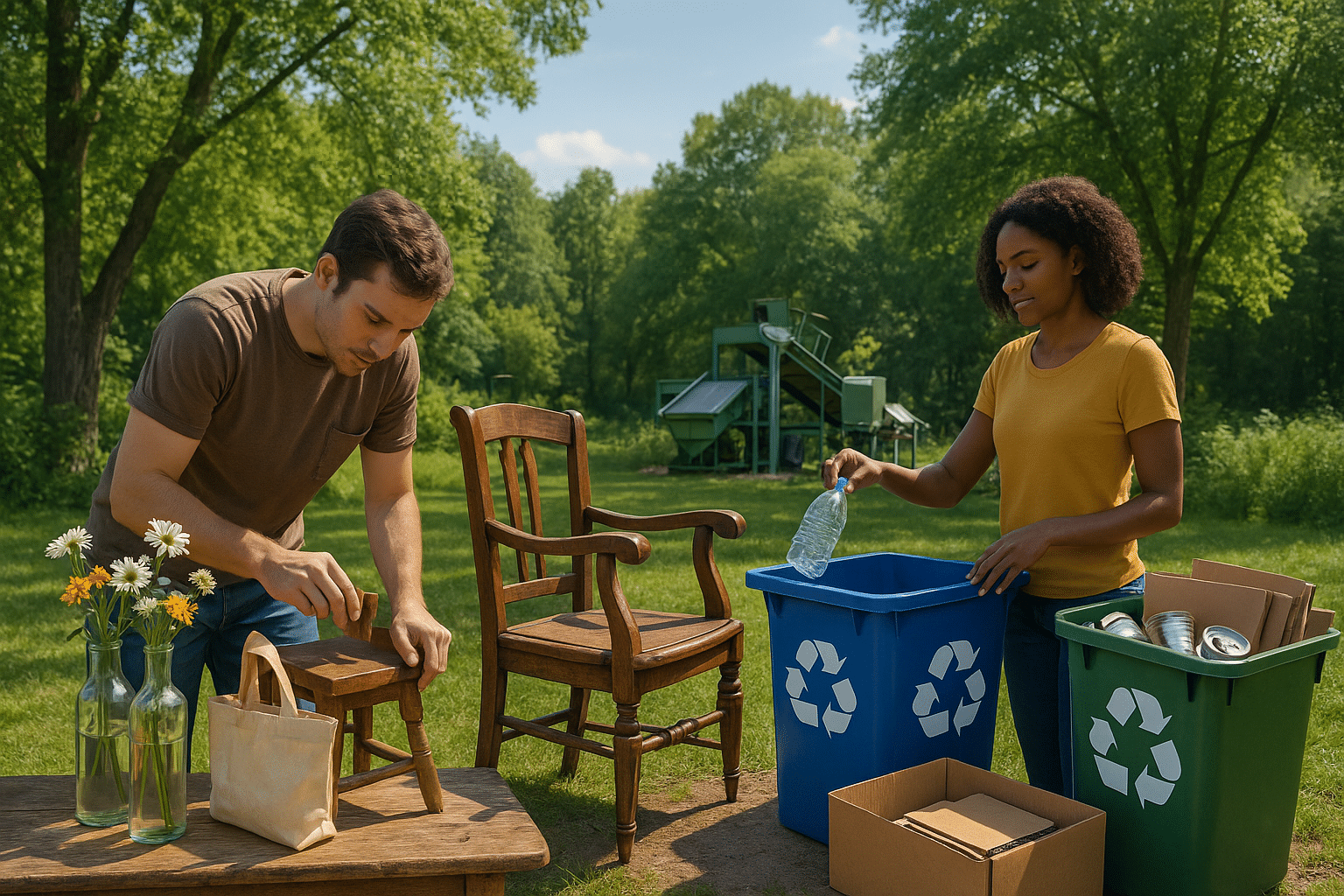🌍 It’s a question that generates considerable debate among environmental enthusiasts, academics, and everyday folks striving for a greener lifestyle. With an increasing focus on sustainability, it’s essential to know which of these practices — reusing or recycling — has a more significant environmental impact. But, as is often the case with complex issues, the answer isn’t as straightforward as you might expect.
In this comprehensive article, we will delve into the intricate world of green choices, examining the environmental impact of both reusing and recycling. 🔄 By looking at various aspects, such as energy consumption, pollution levels, and long-term sustainability, we will try to answer the vital question: Which option is truly sustainable?
The Case for Reusing
There’s a lot to be said for the practice of reusing. On the face of it, reusing seems to be the most eco-friendly option. It involves using an item over and over again, thereby extending its life and reducing the need for new products. Moreover, reusing doesn’t require the energy consumption that recycling does, making it appear to be a more sustainable choice. But is it really?
The Recycling Argument
On the other hand, recycling advocates argue that recycling is the more sustainable practice. ♻️ This process involves collecting and processing materials that would otherwise be thrown away as waste and turning them into new products. Although recycling does require energy, it also conserves natural resources and reduces the amount of waste that ends up in our landfills.
However, the process of recycling is far from perfect. It often involves considerable energy consumption and can sometimes lead to pollution. So, while recycling is undoubtedly a vital part of a sustainable lifestyle, it may not be the ultimate solution to our environmental problems.
Navigating the Grey Area
As we delve deeper into the complexities of reusing vs. recycling, you’ll find there isn’t a clear-cut winner. 🏆 There are scenarios where reusing comes out on top, while in others, recycling may be the more sensible choice. The answer to which option is truly sustainable depends on numerous factors, including the type of material, the energy consumed in the process, and the overall environmental impact.
Throughout this in-depth exploration, we’ll look at the lifecycle of various materials, explore the pros and cons of both reusing and recycling, and discuss some practical steps we can all take to live more sustainably. Because, at the end of the day, sustainability is about more than just reusing or recycling — it’s about making informed choices that benefit our planet and future generations. 🌱
So, whether you’re an environmental enthusiast, a student of sustainability, or simply a curious individual looking to reduce your ecological footprint, this article is for you. Brace yourself for a deep dive into the world of green choices and prepare to have your preconceived notions challenged.
Let’s get started on this journey towards understanding the environmental impact of reusing vs. recycling and determining which option is truly sustainable.👣
Understanding the Environmental Implications: Reusing vs Recycling
When it comes to sustainability, two concepts often arise – reusing and recycling. While both can significantly reduce the amount of waste and raw materials used, they have different environmental implications. To understand which option is truly sustainable, let’s delve into each process’s mechanics, benefits, and potential drawbacks.
Recycling refers to the process of converting waste into reusable materials, while reusing involves using items more than once in their original form. Although both processes can help reduce waste, they require different amounts of energy, resources, and time. Therefore, understanding their environmental impact can help us make informed green choices.
To better understand the environmental implications of each, let’s consider the life-cycle assessment (LCA) – a technique to assess each stage of a product or process’s environmental impacts. The LCA evaluates everything from raw material extraction to end-of-life disposal or recycling, providing a comprehensive view of the environmental impact.
The Life-Cycle Assessment of Recycling
Recycling reduces the need for raw materials and waste in landfills, but it’s not without environmental costs. The process involves collection, sorting, and reprocessing, all of which consume energy and produce greenhouse gas emissions.
Take plastic, for example. While recycling plastic saves about 88% of the energy compared to producing new plastic from raw materials, the process still requires considerable energy. Moreover, not all plastic types are recyclable, resulting in a considerable amount of plastic waste that ends up in landfills or the environment.
The environmental impact of recycling also depends on the efficiency of the recycling system. Mismanagement can lead to contamination, rendering materials unrecyclable and defeating recycling’s purpose. Therefore, while recycling has clear environmental benefits, it’s crucial to improve recycling systems to maximize its sustainability.
The Life-Cycle Assessment of Reusing
Reusing, on the other hand, involves fewer processes, making it generally more energy-efficient than recycling. By using items multiple times, we can significantly reduce the demand for new products and materials, saving energy, and reducing greenhouse gas emissions.
However, the environmental impact of reusing largely depends on the item’s longevity and the frequency of reuse. For instance, a reusable shopping bag must be used over 50 times to have a lower environmental impact than a single-use plastic bag. Therefore, for reusing to be truly sustainable, items must be durable and used repeatedly.
Moreover, reusing doesn’t eliminate the need for recycling. Some items, such as electronics, have limited lifespans and eventually become obsolete or break down. In these cases, recycling is an essential part of the waste management process.
Comparative Analysis: Reusing vs Recycling
To better understand the environmental impact of reusing and recycling, let’s take a look at a comparative analysis. This will help shed light on which option can contribute more towards sustainability.
| Aspect | Reusing | Recycling |
|---|---|---|
| Energy consumption | Lower | Higher |
| Raw material usage | Lower | Higher |
| CO2 Emissions | Lower | Higher |
| Waste Production | Depends on the item’s lifespan | Can be high due to non-recyclable materials |
From the table, it’s clear that reusing often has a lower environmental impact than recycling. However, this doesn’t mean we should stop recycling. Instead, it emphasizes the importance of combining both strategies for maximum sustainability.
Maximizing Sustainability: Combining Reusing and Recycling
The decision between reusing and recycling shouldn’t be an either-or scenario. Instead, we should aim to integrate both into our daily lives to maximize their benefits and minimize our environmental impact. This involves reusing items as much as possible and recycling when they can no longer be used.
For instance, you can reuse glass jars for storage, thus reducing the need for new containers. When these jars become chipped or broken, they can be recycled into new glass products. In this way, reusing and recycling can complement each other, contributing to a more circular economy.
For a more in-depth discussion on combining reusing and recycling for sustainability, I recommend the YouTube video “Reusing vs. Recycling: Which is Better?” by the channel “Seeker.” The video provides a detailed analysis of the two processes, helping you make informed green choices.
Takeaway: Making Green Choices
Making green choices involves more than just choosing between reusing and recycling. It requires understanding the environmental impact of our actions and making informed decisions to reduce our carbon footprint. By combining both reusing and recycling, we can contribute to a more sustainable future.
Remember, every action counts when it comes to sustainability. So, whether you’re reusing a shopping bag or recycling a soda can, know that you’re making a difference. Continue to educate yourself on green choices and spread the word to others. Together, we can make a significant impact on our planet’s health.
Lastly, if you found this article informative and want to learn more about sustainability, make sure to check out other articles on this platform. Keep learning, keep reusing and recycling, and together, let’s make the world a greener place! 🌎

Conclusion
In conclusion, it becomes evident that the realm of IT and Engineering is vast, complex, and ever-evolving, requiring continuous learning and adaptation. Throughout this article, we’ve delved into a plethora of technical concepts and terminologies, all with the intention of delivering a comprehensive understanding to you, the reader.
We first set the stage by exploring the foundational elements that bind together the world of IT and Engineering. From understanding the basic principles of software development to discussing the intricacies of data analysis, we have traversed a varied spectrum of subjects. Each of these components forms a crucial part of this multifaceted field, highlighting the breadth of knowledge required to excel in it.
Next, we delved into the more intricate details, analyzing the different methodologies and processes that are commonly employed. We examined Agile methodology, iterative development, and other prevalent strategies in the software engineering field. These detailed discussions were intended not only to introduce these concepts but also to emphasize their significance in practical scenarios.
Furthermore, we have examined how data analysis has become a vital cog in the machinery of any IT-related venture. We have discussed the various methods and techniques used to collect, process, and interpret data, underscoring the relevance of effective data management in making informed decisions and strategic planning.
The role of AI and Machine Learning in the current IT landscape was another crucial topic that we dissected. With the increasing integration of these technologies into our daily lives, it becomes essential for us to understand their underlying principles and potential applications.
This article has been an expedition, a journey through the intricate landscapes of IT and Engineering. I hope that it has served as a helpful guide, providing you with valuable insights and sparking your curiosity for further exploration. As we advance further into the digital age, understanding these concepts is not just useful but necessary.
So, what’s next? I encourage you to apply this knowledge and share it with your colleagues. Let’s continue the conversation, share your thoughts, or questions in the comments section below 👇. Remember, knowledge grows when shared. If you found this article valuable, don’t hesitate to share it on your social platforms 🚀.
For more insights and in-depth exploration of these topics, refer to these sources:
1. W3Schools – A comprehensive resource for IT and programming-related topics.
2. Mozilla Developer Network (MDN) – A rich repository of detailed documentation and learning resources for web technologies.
3. Codecademy – An interactive platform that offers hands-on coding tutorials.
And, as always, keep learning, keep exploring, and keep pushing the boundaries of your knowledge 🚀.
Author: Rodrigo Almeida



